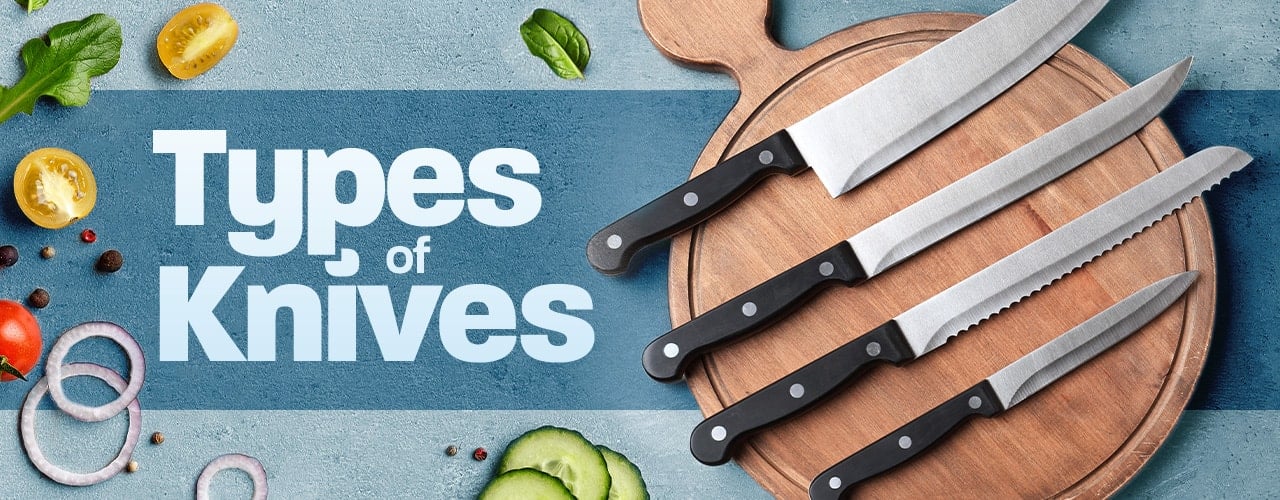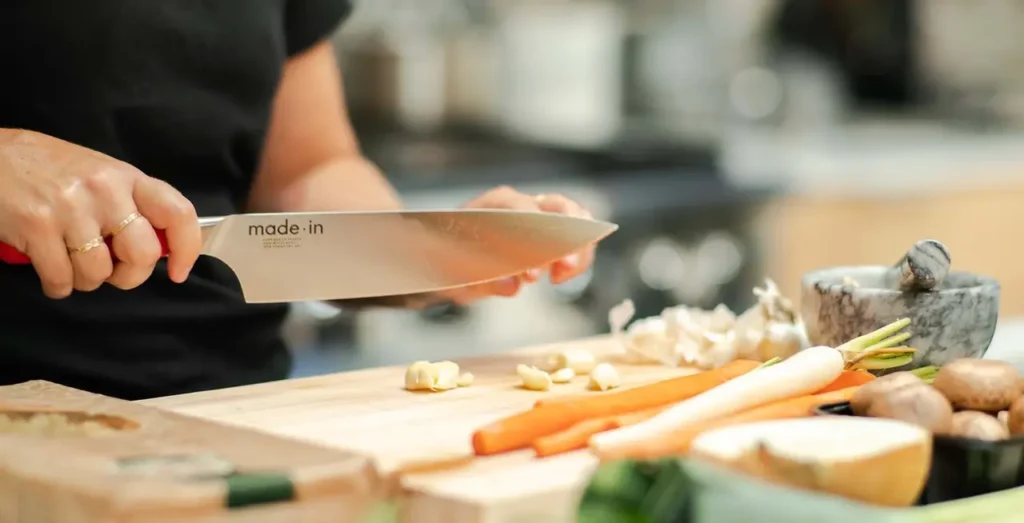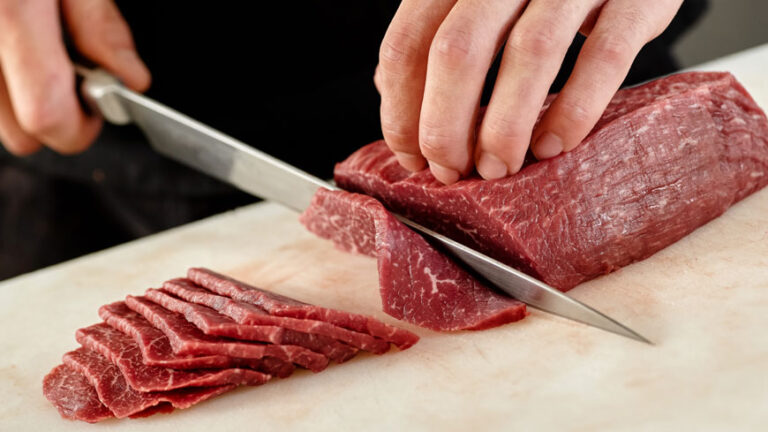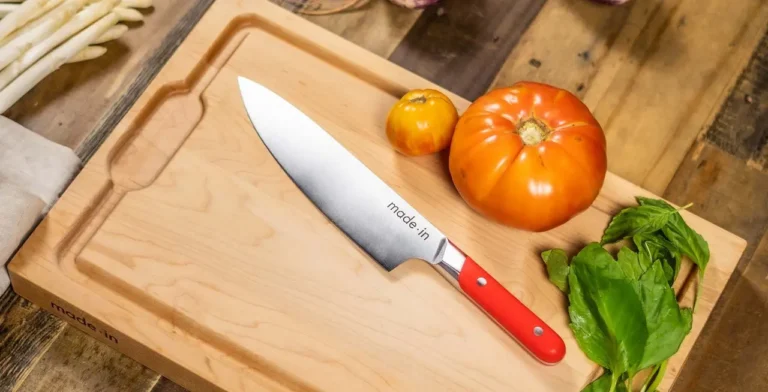Most Popular Types Of Kitchen Knives And Their Uses
Kitchen knives are an essential part of your kitchen for easy, fast, and safe cooking. It is a kitchen tool used for preparing food in the kitchen including a chef knife, Santoku, and other knives. They may be of Japanese or German style. Stainless steel or carbon steel is used for their manufacturing.

Choosing the best kitchen knife among so wide range is quite a hectic task. But you don’t need to worry about it. In this article, we reviewed the most popular types of kitchen knives along with a buying guide that will help you to choose one that meets your requirements.
1. Chef Knife
A chef’s knife is multipurpose and is used by cooks and professionals. It is essential in professional kitchens and is most widely used. You need a gadget for cutting purposes when you enter your kitchen.

A good chef’s knife should have the capability of slicing, dicing, chopping, and smashing. Such knives are expensive to some extent but if you find a sharp blade, highly durable handle, and a good-looking knife in your budget, it will be awesome.
Key Features
- Thick and round blade.
- Available in size range of 6-12 inches.
- No sticking of food with handle.
- It has a full tang construction.
- An ergonomic handle gives for easy grip and control during use.
Main Uses
A chef’s knife is mostly used for;
- Cutting through a variety of food ingredients.
- Slicing cucumbers.
- Chopping herbs.
- Splitting and cutting chicken.
- Mincing garlic.
- Chopping vegetables.
2. Utility Knife
A utility knife is similar to a chef knife in various features irrespective of the thinner and smaller blade of a utility knife. They are used for delicate cutting purposes. The blade is much sharper than a chef’s knife. Also, The characteristics ability of use, durability, and versatility distinguish them from other knives.
Key Features
- Highly versatile
- Easy to handle
- Blade length ranges from 4-7 inches
- Thin, small, and sharp blade for cutting small-sized ingredients
Main Uses
Utility knives are used for;
- Slicing of fruits and vegetables.
- Slicing and cutting meat.
- Slicing fish and herbs.
- Making platter.
3. Paring Knife
Paring knives are well recognized due to their extra sharpness, small size, and aesthetics. They are lightweight and provide high precision. Additionally, they give smooth and accurate cuts. The handling of such knives is very easy. They are best used for peeling fruits and vegetables.
Key Features
- Provide precise and accurate cuts.
- Best for complex cutting.
- Available in different varieties.
- Extreme sharpness.
Main Uses
Paring knives are best used for;
- Getting off the soft skin of plums and peaches.
- Peeling off apple and mango skin.
- Preparing garnishes.
- Cutting of citrus fruit without damaging the ingredients and pulp.
4. Santoku Knife
The Santoku is a Japanese western style multi-purpose knife. It is used for dicing, slicing, and chopping meat, fish, and vegetables. Many types of santoku knives are available in the market depending upon their features and use. Additionally, they are single bevels meaning that the blade tapers to the edge on only one side. They are versatile and have three main functions i.e. slicing, dicing, and chopping.
Many Santoku knives have dimples on the blade known as Granton. These Grantons prevent friction while slicing the food. They also keep away the sticking of food to the blade. The risk of slipping of hand is also reduced due to these dimples.
Key Features
- Useful for fine cutting of vegetables and other food.
- Appropriate for cutting smaller vegetables.
- Attractive Japanese-style design.
- Short and thin.
- Can cut without rocking motion.
- Features a flat blade.
Main Uses
Santoku knives are used for three main purposes mincing, dicing, and slicing. They are used for;
- Cutting cheese.
- Dicing and chopping vegetables and fruits.
- Chopping nuts.
- Meat cutting.
- Mincing herbs.
5. Nakiri Knife
The Nakiri knife is characterized by its rectangular blade shape, with a straight edge that is sharpened on both sides. This design allows for easy and precise cutting of vegetables. It is especially well-suited for tasks such as chopping and slicing. Moreover, they have a rectangular blade shape with a straight edge that is sharpened on both sides. They are typically made from high-carbon steel, which is known for its sharpness, durability, and ability to hold a fine edge.
Some types of Nakiri knives use harder stainless steel alloy which makes them more durable. But they are harder to sharpen. They have a wooden handle made from magnolia wood or pakkawood. These handles are designed to provide a comfortable and secure grip. They provide precision and control during cutting.
Key Features
- Hollow ground and sharp.
- Produce clean cuts.
- Best for cutting tough vegetables.
- Long, sharp, and straight blade.
Main Uses
Nakiri knives are used for;
- Cutting thin slices.
- Cutting fruits and vegetables like lettuce and cabbage.
- Cutting greens for salad and soups.
- Cutting cucumber, onions, and tomatoes.
5. Tomato Knife
Tomato knives are used for making food in which they remain visible. As tomatoes have delicate and soft skin, a specifically designed knife is used for its cutting. These knives are usually lightweight and can cut without squashing and damage of interior ingredients.
Key Features
- Lightweight.
- Short and sharp serrated blade.
- 6-7 inches in length.
- Useful for easy cutting of smaller vegetables.
- Easy to use and control.
Main Uses
Tomato knives are mainly designed for cutting tomatoes.
6. Filleting Knife
Filleting knife ranges in size from 6-11 inches in length. They have some similarities with a boning knife. Filleting knife comes with a sharp, thin, flexible, and long blade. Their blade is extraordinarily thin and sharper than other knives. The pointed tip is responsible for clean, precise, and easy cuts. The flexible nature prevents damage to fish or meat flesh.
Key Features
- Flexibility.
- Razor-sharp blade.
- Easy and precise cutting.
- Versatility.
- 6-11 inches long blade.
Main Uses
A fillet knife is used for;
- Filleting fish.
- Filleting chicken.
- Deveining prawns.
- De-boning, trimming, and skinning fish.
7. Meat Cleaver/ Butcher Knife
Butcher Knives are available in different sizes and weights with rectangular and flat blades. They are used for chopping meat with efficiency. You can hang them when not in use due to the presence of a hole near the spine. They are used to remove the peel from ginger and garlic before mincing. They feature a curved, thick, and long blade for smooth slicing.
Key Features
- Curved, thick, and long blade for smooth slicing.
- Sharp.
- Available in different designs and weights.
Main Uses
The butcher’s knife is suitable for;
- Cutting meat.
- Removing, chopping, and cleaving heads off fish.
8. Boning Knife
The boning knife is usually smaller in size with a length of 6 inches. They have pointed tips, sharp edges, and narrow blades. One of its amazing features is easy and comfortable use. It is lightweight. The flexible blade provides additional uniqueness.
The blade of such knives can easily enter inside the spaces of meat and cut them without damage other knives do not have this feature. They can also separate bones and joints from the flesh. They are well suited for poultry and the skinning of fish.
Key Features
- Flexible and narrow blade.
- Easy to use.
Main Uses
Boning knives are best used for;
- Separating bones from meat without damaging the surrounding flesh.
- Removing the skin of fish.
- Poultry.
9. Carving Knife
The carving knives have various cavities that prevent food from sticking and are useful for the easy release of slices. They have high cutting precision due to long and narrow blades. The presence of indentations decreases the friction and drag force during cutting. They give smooth and clean cuts of meat. A carving knife can also be used for slicing and cutting wide pieces of beef, lamb as well and pork. In short, carving knives are the best addition to your kitchen.
Key features
- Less friction.
- Precise cutting.
- Easy slicing.
- Narrow, thin blade.
Main Uses
Carving knives are generally used to carve thin uniform slices from cooked poultry like turkey or chicken, and to slice large roasts of meat. They can sometimes be used for filleting huge fish.
10. Salmon Knife
Salmon kitchen knives are well known for their flexibility. They feature ground, long, and sharp blades. These blades with rounded tips are best for precise cutting. These knives cut delicate meat without damaging flesh.
The clefts on both sides of the blade reduce the friction while using a knife. It also prevents the sticking of food ingredients to the knife. The delicate and sharp blade is best for filleting large fish and slicing tuna without any damage. In short, Salmon knives are amazing in action and you will enjoy their use.
Key Features
- Long and flexible blade.
- Less friction during use.
- Prevent tearing flesh.
- Give smooth cuts.
Main Uses
A Salmon Knife is used for;
- Cutting and slicing fish like salmon and tuna.
- Filleting large fish.
- Sectioning pastries and cakes.
How To Choose the Best Kitchen Knife Type
Following is some basic information about the kitchen knife that must be considered before selecting the best among all;
1. Choosing The Material And Design
Kitchen knives are made from different materials and have various designs. The choice of a knife depends upon the material, design, and use. Knowing these things helps you choose the better one.
Kitchen knives can be stamped or forged. A single sheet of metal is used for making a stamped knife. The blade is designed with the help of a stamping machine. Such knives are suitable for short-handed chefs.
Forged knives are forged from a single piece of metal through hammering. After that, it is sharpened and honed. Forged knives are preferred over stamped knives due to more durability. In short, forged knives are long-lasting but expensive while stamped knives have an affordable range. Again the choice of the knife should be based on the type and manufacturing brand rather than its stamped or forged nature.
2. Choosing The Best Blade Material
Different Kitchen knives are made from different materials. Their blade material also varies from one type of knife to another. Some of the most important blade materials are given below;
Stainless Steel
Stainless steel is one of the most durable materials which are resistant to corrosion and less susceptible to rust. The knives having stainless steel blades are highly durable.
Carbon Steel
Some kitchen knife blades are made from carbon steel. They are well known for their quality and durability. Steel alloy containing carbon and iron is used to make these blades. The knives having a high content of carbon are considered high-quality knives.
Ceramic
Ceramics is another important material used for making knife blades. Ceramic knives are rigid, durable, lightweight, and hard. They are made from zirconium dioxide and have an appealing appearance. One of the drawbacks is brittleness which may cause breakage if more pressure is applied.
Damascus steel
Damascus steel is long-lasting and expensive. These knives are more popular for their extraordinary durability than other knives. They are made from different alloys which give them an aesthetic and nice pattern.
Titanium
Kitchen knives made from titanium material are resistant to corrosion and rust. Although this material is famous for durability it becomes dull with time. So, such knives cannot be the first preference.
The selection of knives based on blade material depends on your choice. You may use one of them before purchasing a full set or collection of sets.
3. Choosing The Right Handle Type
Kitchen knives with various types of handles are available in the market. They can be made of wood material, plastic, riveted, or polymer-like styrene. The selection of the right type of handle again depends upon your choice because some are lightweight and other is heavy. So, which is suitable for you depends upon the needs of your tasks.
Tips To Maintain Your Kitchen Knives
Proper care and maintenance of kitchen knives are important to keep them in good condition. Following are some tips to maintain the sharpness and condition;
- Wash and clean the knife immediately after use and do not leave them in the sink.
- Dry it completely with a clean cloth.
- Store them in a knife box after use.
- Do not leave them in the dishwasher for a long time because it causes rusting and corrosion.
- Do frequent sharpening to keep them sharp.
- Use a cutting board made from wood and avoid the use of glass or any other material to avoid damage to the knife.
Final Thought:
Summing up, the best quality kitchen knife can make a positive difference in your cooking experience. Having the best type of knife increases the efficiency and speed of your work. You should select a kitchen knife that fulfills your kitchen needs and is safer.
All kitchen knives are the best in quality and can handle different tasks. As different kitchen knives have different uses, you can choose which is the requirement. Kitchen knives are also available in various price ranges. If your budget is low then a chef knife is a good option. Utility knives are also a good option due to their versatility.
We reviewed different types of kitchen knives and their uses with the ultimate buying guide to make it easy to select a better one. After understanding the types of kitchen knives, it is up to your requirements and preferences to select one of them.


